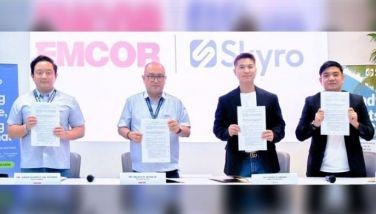Who has priority to the shares of stock – an attaching creditor or the subsequent buyer?
December 9, 2003 | 12:00am
Shares of stock are attached pursuant to a writ of preliminary attachment issued against the shareholder. The same shares are subsequently sold to a third party who does not know of the attachment. Who has priority to the shares of stock – the attaching creditor or subsequent buyer?
The case of Chemphil Export and Import Corporation (CEIC) vs. Court of Appeals, 251 SCRA 257 (1995), is instructive. This case ("CEIC case") involved a consortium of banks which obtained a writ of preliminary attachment in a civil case ("consortium case") over shares of stock belonging to Mr. Antonio Garcia in the Chemical Industries of the Philippines ("Chemphil"). The attachment, which was served on the secretary to the President of Chemphil on 19 July 1985, was not registered in the stock and transfer book of Chemphil. A few years thereafter, or on 15 July 1988, Mr. Garcia sold the same shares of stock to the Ferro Chemicals, Inc. ("FCI") for P79 million. FCI subsequently assigned the shares to the Chemphil Export and Import Corporation ("CEIC"). The shares were registered and recorded in the corporate books of Chemphil in CEIC’s name and the corresponding stock certificates were issued to it.
The consortium case was appealed to the Court of Appeals. While the appeal was pending, Mr. Garcia and the bank consortium amicably settled the case whereby the former agreed to pay P145 million to the latter. The Court of Appeals rendered a judgment by compromise. Unfortunately, Mr. Garcia failed to comply with the compromise agreement. The consortium of banks caused to be sold on execution the shares of stock (earlier attached by them), which were the same shares subsequently sold by Mr. Garcia to CEIC. A certificate of sale covering the shares was issued in the name of the bank consortium.
The Supreme Court stated that "the issue in the instant case... is the priority between an attaching creditor (the consortium) and a purchaser (FCI/CEIC) of the disputed shares of stock and not between two attaching creditors"?
The Supreme Court ruled that the attachment lien acquired by the bank consortium is valid and effective even as against the buyer (FCI) and its assignee (CEIC), notwithstanding the fact that said attachment lien was not registered in the corporate books of Chemphil. "Both the Revised Rules of Court and the Corporation Code", according to the Court, "do not require annotation in the corporation’s stock and transfer book for the attachment of shares of stock to be valid and binding on the corporation and third party." Consequently, when FCI purchased the shares of stock from Mr. Garcia, it purchased them subject to the attachment lien of the bank consortium. In this regard, the High Court explained that a preliminary attachment is a security for the satisfaction of whatever judgment may be obtained by the attaching creditor in a court action, which continues until the judgment debt is fully satisfied.
So the answer to the question is that the attaching creditor enjoys priority to the shares of stock. But what if the claimants are two attaching creditors? Both writs of attachment were properly served. The writ that was served earlier was not registered while the writ that was served later was registered or annotated in the books of the company. What if there is defective service of any of the writs of preliminary attachment? Would the CEIC case apply? Well, these things can be subject of another column!
(The author is a senior partner and the co-managing partner of the Angara Abello Concepcion Regala and Cruz Law Offices or ACCRALAW. He may be contacted through [email protected]).
The case of Chemphil Export and Import Corporation (CEIC) vs. Court of Appeals, 251 SCRA 257 (1995), is instructive. This case ("CEIC case") involved a consortium of banks which obtained a writ of preliminary attachment in a civil case ("consortium case") over shares of stock belonging to Mr. Antonio Garcia in the Chemical Industries of the Philippines ("Chemphil"). The attachment, which was served on the secretary to the President of Chemphil on 19 July 1985, was not registered in the stock and transfer book of Chemphil. A few years thereafter, or on 15 July 1988, Mr. Garcia sold the same shares of stock to the Ferro Chemicals, Inc. ("FCI") for P79 million. FCI subsequently assigned the shares to the Chemphil Export and Import Corporation ("CEIC"). The shares were registered and recorded in the corporate books of Chemphil in CEIC’s name and the corresponding stock certificates were issued to it.
The consortium case was appealed to the Court of Appeals. While the appeal was pending, Mr. Garcia and the bank consortium amicably settled the case whereby the former agreed to pay P145 million to the latter. The Court of Appeals rendered a judgment by compromise. Unfortunately, Mr. Garcia failed to comply with the compromise agreement. The consortium of banks caused to be sold on execution the shares of stock (earlier attached by them), which were the same shares subsequently sold by Mr. Garcia to CEIC. A certificate of sale covering the shares was issued in the name of the bank consortium.
The Supreme Court stated that "the issue in the instant case... is the priority between an attaching creditor (the consortium) and a purchaser (FCI/CEIC) of the disputed shares of stock and not between two attaching creditors"?
The Supreme Court ruled that the attachment lien acquired by the bank consortium is valid and effective even as against the buyer (FCI) and its assignee (CEIC), notwithstanding the fact that said attachment lien was not registered in the corporate books of Chemphil. "Both the Revised Rules of Court and the Corporation Code", according to the Court, "do not require annotation in the corporation’s stock and transfer book for the attachment of shares of stock to be valid and binding on the corporation and third party." Consequently, when FCI purchased the shares of stock from Mr. Garcia, it purchased them subject to the attachment lien of the bank consortium. In this regard, the High Court explained that a preliminary attachment is a security for the satisfaction of whatever judgment may be obtained by the attaching creditor in a court action, which continues until the judgment debt is fully satisfied.
So the answer to the question is that the attaching creditor enjoys priority to the shares of stock. But what if the claimants are two attaching creditors? Both writs of attachment were properly served. The writ that was served earlier was not registered while the writ that was served later was registered or annotated in the books of the company. What if there is defective service of any of the writs of preliminary attachment? Would the CEIC case apply? Well, these things can be subject of another column!
(The author is a senior partner and the co-managing partner of the Angara Abello Concepcion Regala and Cruz Law Offices or ACCRALAW. He may be contacted through [email protected]).
BrandSpace Articles
<
>
- Latest
- Trending
Trending
Latest
Trending
Latest
Recommended
































